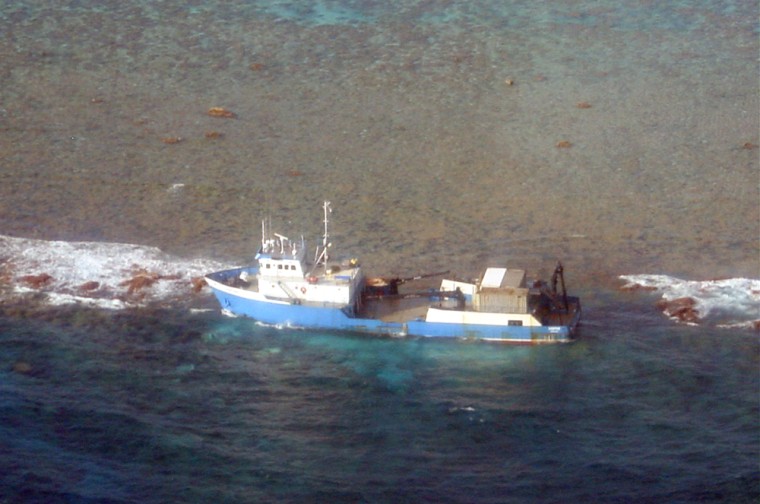The managers of the national wildlife refuge where a debris cleanup ship ran aground are "very concerned" about potential damage to the remote area's treasured reef and ecosystem, a spokeswoman said Tuesday.
The delicate character of the accident site in the Northwestern Hawaiian Islands, a breeding ground for endangered monk seals, has generated worries about potentially severe and long-lasting spoilage from the environmental cleanup project that somehow went terribly wrong.
The possibility of oil leaking from the vessel, after a half-mile long sheen was spotted in the water nearby, or of the coral reef suffering harm from the impact of the ship running aground over the weekend were both troubling.
"We're very concerned," said Barbara Maxfield, a spokeswoman for the U.S. Fish and Wildlife Service. "We have significant sea birds, Hawaiian monk seals, green sea turtles, spinner dolphins, and the coral reefs and all their inhabitants, on those islands."
The Casitas ship was in the Northwestern Hawaiian Islands to pick up fishing nets and other debris when it ran aground at 2 a.m. Saturday on Pearl and Hermes Atoll, about 1,000 miles northwest of Honolulu.
Sheen spotted
A Coast Guard C-130 plane monitoring the accident site by air spotted a sheen in the water on Sunday and Monday.
Three Coast Guard pollution control experts left Oahu Tuesday morning to assess the source and extent of the discoloration. The group also planned to evaluate what steps they should take to clean up any leakage and contain any damage.
While the crew aboard the plane was unable to see the sheen on Tuesday, authorities were not letting their guard down because such a sheen can disappear and show up again in water.
The 145-foot long ship was loaded with an estimated 30,000 gallons of diesel fuel, 3,000 gallons of gasoline and 200 gallons of lubricating oil.
The waters immediately adjacent to most of the atolls in the Northwestern Hawaiians Islands were designated a national wildlife refuge by President Theodore Roosevelt in 1909.
Largest protected area
A December 2000 executive order signed by President Clinton set aside 84 million acres of ocean around the archipelago as the Northwestern Hawaiian Island Coral Reef Ecosystem Reserve, the largest protected area ever established in the United States.
The islands, which extend 1,200 miles from the main Hawaiian Islands, are home to more than 70 percent of the nation's coral reefs and to endangered Hawaiian monk seals and other sea life.
Alan Friedlander, a fisheries ecologist, said the Northwestern Hawaiian Islands are of "monumental" significance to the world as well as Hawaii and the United States.
"It's one of the last remaining nearly pristine coral reef ecosystems on earth," said Friedlander, who is with the National Ocean Services division of the National Oceanic and Atmospheric Administration.
He noted the coral reefs in the area are generally free of disease. Its relative isolation, meanwhile, have protected the area's sharks, jack fish and other big predator species from overfishing.
Unique intact ecosystem
Since the bigger fish control a lot of dynamics of what goes on in an ecosystem, environments can become unstable or dysfunctional without them, Friedlander said.
"There is no place that really rivals the Northwestern Hawaiian Islands as far as being a large, intact, functioning ecosystem that has all the elements in place and that has very little impact from humans," Friedlander said.
The Pearl and Hermes Atoll alone is notable because 25 percent of the species that live there are found nowhere else on earth.
There were no injuries to those aboard the Casitas and the cause of the accident was unknown. The seven crew and 16 researchers with the University of Hawaii and NOAA evacuated to a nearby island Saturday night before being taken to Midway Island, and were due to fly back to Oahu Tuesday evening.
